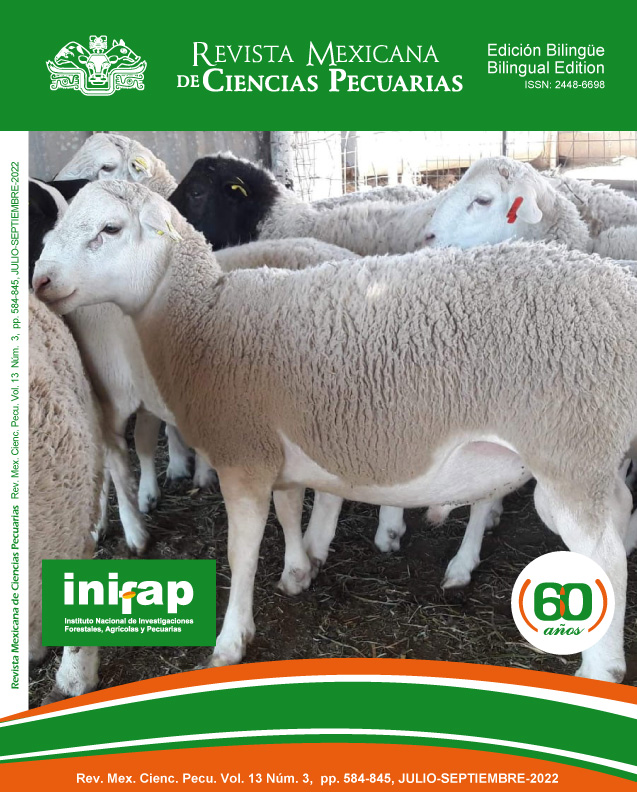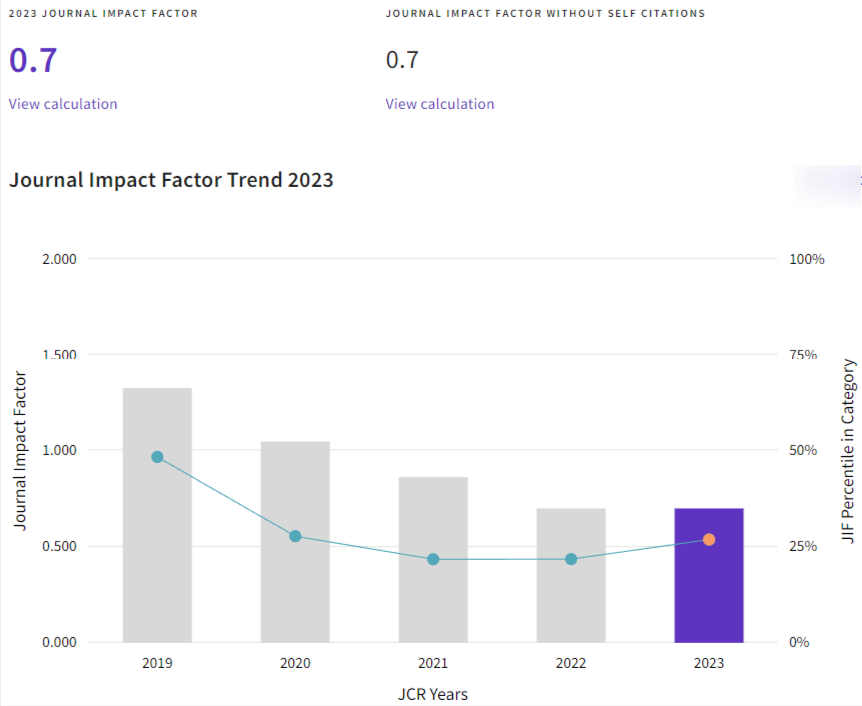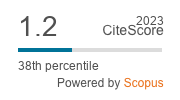Establishment of tropical forage grasses in the Cerrado biome
DOI:
https://doi.org/10.22319/rmcp.v13i3.6039Palabras clave:
Morphogenesis, Megathyrsus maximus, Pasture, Urochloa brizanthaResumen
This study was carried out to evaluate the time for the establishment of tropical forage grasses in the “Cerrado” biome, based on morphogenetic and structural traits. Three Brachiaria brizantha (Syn. Urochloa brizantha) cultivars (Paiaguás, Ipyporã and Marandu) and two Panicum maximum (Syn. Megathyrsus maximus) cultivars (Quênia and Tamani) were distributed in a randomized-block design with four replicates. Morphogenetic and structural traits of the pasture were assessed from d 35 to d 65 after sowing, at seven-day interval. Canopy height rose linearly with the establishment period, in all cultivars. In the Megathyrsus cultivars, tiller density decreased as the experimental period progressed, whereas the number of tillers in the Urochloa cultivars increased. The cultivars Ipyporã and Marandu had the highest leaf appearance rates. The lowest leaf elongation rates occurred in the cultivars Paiaguás, Ipyporã and Tamani, and the highest elongation rates in cv. Quênia. As a result, cv. Quênia showed the highest values of final leaf length (64.9 cm) and leaf blade mass (3,352.9 kg DM ha-1). The higher senescence rate of cv. Tamani (2.1 cm tiller-1 d-1) resulted in the highest percentage of dead material (1,815.5 kg ha-1) being found in the herbage mass of this cultivar. Cultivars Paiaguás, Marandu and Tamani were established at 44 d, whereas cv. Quênia and Ipyporã were established at 51 and 58 d after sowing, respectively, in the Brazilian Cerrado.
Descargas
Citas
Euclides VPB, Montagner DB, Macedo MCM, Araújo AR, Difante GS, Barbosa RA. Grazing intensity affects forage accumulation and persistence of Marandu palisadegrass in the Brazilian savannah. Grass Forage Sci 2019;75(1):1-13.
Véras ELL, Difante GS, Gurgel ALC, Costa ABG, Rodrigues JG, Costa CM, et al. Tillering and structural characteristics of Panicum cultivars in the Brazilian semiarid region. Sustainability 2020;12(9):3849.
Pereira OJR, Ferreira LG, Pinto F, Baumgarten L. Assessing pasture degradation in the Brazilian Cerrado based on the analysis of MODIS NDVI time-series. Remote Sens 2018;10(11):1761.
Dias-Filho MB. Formação e manejo de pastagens. Embrapa Amazônia Oriental-Comunicado Técnico 2012;235:1-9.
Rodrigues JG, Difante GS, Gurgel ALC, Veras ELL, Costa ABG, Pereira MG, et al. Establishment of Brachiaria cultivars in the soil-climatic conditions of the Brazilian semi-arid region. Acta Sci Anim Sci 2021;43: e51802.
Costa ABG, Difante GS, Gurgel ALC, Veras ELL, Rodrigues JG, Pereira MG, et al. Morphogenic and structural characteristics of Panicum cultivars during the establishment period in the Brazilian Northeast. Acta Sci Anim Sci 2021;43:e50984.
EMBRAPA. Empresa Brasileira de Pesquisa Agropecuária. Sistema Brasileiro de Classificação de Solos. 3th ed. Rio de Janeiro, Brasil: Centro Nacional de Pesquisa de solo; 2013.
Lemaire G, Chapman D. Tissue flows in grazed plant communities. In: Hodgson J, Illius AW, editores. The ecology and management of grazing systems. 1rst ed. Wallingford, UK: CABI Publishing; 1996:3-29.
Giacomini AA, Silva SC, Sarmento DOL, Zeferino CV, Souza Júnior SJ, Trindade JK, et al. Growth of Marandu palisadegrass subjected to strategies of intermittent stocking. Sci Agric 2009;66(6):733-741.
Euclides VPB, Montagner DB, Barbosa RA, Valle CB, Nantes NN. Animal performance and sward characteristics of two cultivars of Brachiaria brizantha (BRS Paiaguás and BRS Piatã). R Bras Zootec 2016;45(3):85-92.
Echeverria JR, Euclides VPB, Sbrissia AF, Montagner DB, Barbosa RA, Nantes NN. Forage accumulation and nutritive value of the Urochloa interspecific hybrid 'BRS RB331 Ipyporã' under intermittent grazing. Pesqui Agropecu Bras 2016;51(7): 880-889. doi:10.1590/S0100-204X2016000700011.
Andrade CM, Farinatti LH, Nascimento HL, Abreu ADQ, Jank L, Assis GM. Animal production from new Panicum maximum genotypes in the Amazon biome, Brazil. Trop Grassl Forr Trop 2013;1(1):36-38.
Tesk CR, Cavalli J, Pina DS, Pereira DH, Pedreira CG, Jank L, et al. Herbage responses of Tamani and Quênia guinea grasses to grazing intensity. Agron J 2020; 112(3):2081-2091.
Montagner DB, Nascimento Júnior D, Vilela HH, Sousa BML, Euclides VPB, Silva SC, et al. Tillering dynamics in pastures of guinea grass subjected to grazing severities under intermittent stocking. R Bras Zootec 2012;41(3):544-549.
Sbrissia AF, Schmitt D, Duchini PG, da Silva SC. Unravelling the relationship between a seasonal environment and the dynamics of forage growth in grazed swards. J Agron Crop Sci 2020;206(5):630-639.
Luna AA, Difante GS, Montagner DB, Emerenciano Neto JV, Araújo IMM, Oliveira LEC. Características morfogênicas e acúmulo de forragem de gramíneas forrageiras sob corte. Biosc J 2014;30(6):1803-1810.
Sbrissia AF, Duchini PG, Zanini GD, Santos GT, Padilha DA, Schmitt D. Defoliation strategies in pastures submitted to intermittent stocking method: Underlying mechanisms buffering forage accumulation over a range of grazing heights. Crop Sci 2018;58(2):945-954.
Gastal F, Lemaire G. Defoliation, shoot plasticity, sward structure and herbage utilization in pasture: Review of the underlying ecophysiological processes. Agriculture 2015;5(1):1146-1171.
Difante GS, Nascimento Júnior D, Silva SC, Euclides VPB, Montagner DB, Silveira MCT, et al. Características morfogênicas e estruturais do capim-marandu submetido a combinações de alturas e intervalos de corte. Rev Bras Zootec 2011;40(5):955-963.
Sousa BML, Nascimento Júnior D, Silva SC, Monteiro HCF, Rodrigues CS, Fonseca DM, et al. Morphogenetic and structural characteristics of Andropogon grass submitted to different cutting heights. Rev Bras Zootec 2010;39(10):2141-2147.
Véras ELL, Difante GS, Gurgel ALC, Costa CM, Emerenciano Neto JV, Rodrigues JG, et al. Tillering capacity of Brachiaria cultivars in the Brazilian Semi-Arid Region during the dry season. Trop Anim Sci J 2020;43(2):133-140.
Euclides VPB, Valle CB, Macedo MCM, Almeida RG, Montagner DB, Barbosa RA. Brazilian scientific progress in pasture research during the first decade of XXI century. Rev Bras Zootec 2010;39(Suppl Spec):151-168.
Zanine A, Farias L, Ferreira D, Farias L, Ribeiro M, Souza A, et al. Effect of season and nitrogen fertilization on the agronomic traits and efficiency of Piatã grass in Brazilian savanna. Agriculture 2020;10(8):337.
Sousa CCC, Montagner DB, Araújo AR, Euclides VPB, Difante GS, Gurgel ALC, et al. The soil-plant interface in Megathyrsus maximus cv. Mombasa subjected to different doses of nitrogen in rotational grazing. Rev Mex Cienc Pecu 2021;12(4): 1098-1116.
Descargas
Publicado
Cómo citar
-
Resumen806
-
PDF 290
-
PDF194
-
Full text 402
Número
Sección
Licencia
Los autores/as que publiquen en la Revista Mexicana de Ciencias Pecuarias aceptan las siguientes condiciones:
De acuerdo con la legislación de derechos de autor, la Revista Mexicana de Ciencias Pecuarias reconoce y respeta el derecho moral de los autores/as, así como la titularidad del derecho patrimonial, el cual será cedido a la revista para su difusión en acceso abierto.

Esta obra está bajo una Licencia Creative Commons Atribución-NoComercial-CompartirIgual 4.0 Internacional.





